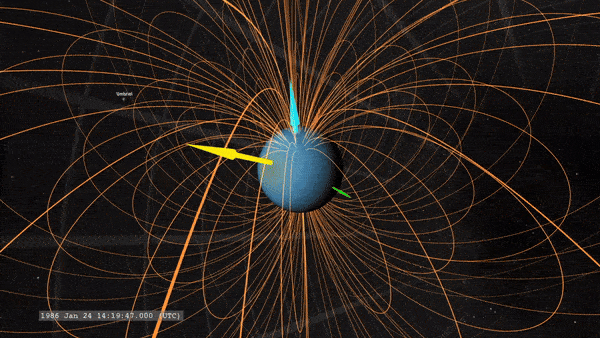Some of the apparent quirks of Uranus may be due to bad timing.
In 1986, the Voyager 2 spacecraft flew past the planet, recording the mysteries of its magnetic field. It turns out that Uranus may have been in an unusual state. A solar wind event days before the flyby compressed the giant planet’s magnetosphere, researchers report Nov. 11 in Astronomy of Nature. This compression may explain some long-standing puzzles about Uranus and its moons and may inform planning for future missions. (SN: 4/20/22).
“We just caught it at this eerie moment in time,” says Jamie Jasinski, a space plasma physicist at NASA’s Jet Propulsion Laboratory in Pasadena, California. “
Voyager 2 discovered that Uranus’ magnetosphere, the bubble of magnetism that surrounds a planet, was strange. It appeared to lack plasma, a common component of other planets’ magnetospheres. And there were inexplicably intense bands of energetic electrons.
Jasinski and colleagues looked back at Voyager 2 data collected months before the flyby (SN: 2/1/86). The team found that the density and speed of the solar wind, a stream of charged particles emanating from the sun, increased steadily for days.
The pressure from that solar wind would have compressed Uranus’ magnetosphere, reducing its extent from about 28 times the diameter of Uranus to more than 17 times within a week. Compression may account for the lack of plasma and intense radiation belts, Jasinski says.

In fact, Uranus is in the state Voyager 2 found it in only 4 percent of the time, the team calculated. This means that much of what we know about Uranus’ magnetosphere does not represent a typical day there.
“We don’t know anything about Uranus because it was a single flyby,” says Corey Cochrane, a space physicist also at JPL.
On the plus side, the new discovery means it may be easier for some future missions to search for oceans beneath the surface of Uranus’ moons Titania and Oberon.
Astronomers can detect oceans on icy moons if they orbit inside the magnetosphere (SN: 10/8/24). Saltwater responds to the magnetic field around it and produces its own magnetic field, which the spacecraft can pick up. If Uranus’ magnetosphere is normally larger than documented by Voyager 2, those moons should be well within it – and therefore good places to look for subsurface seas.
#Uranus #looked #strange #NASAs #Voyager #flew
Image Source : www.sciencenews.org